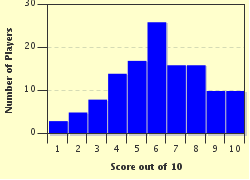Quiz Answer Key and Fun Facts
1. Let's start with which is the largest desert in the world?
2. Antarctica is considered to be a cold or polar desert. Strangely, perhaps, there are some areas which are snow-free. One such area is the McMurdo Dry Valleys. Name one of the major contributing factors causing this.
3. Think of Antarctica and snow, ice and freezing temperatures come to mind. There was, however, one lake in Victoria Land which almost never froze. What prevented Don Juan Pond from freezing even when temperatures dropped to minus 30 degrees Celsius/minus 22 Fahrenheit?
4. When most people think of deserts, it is of sand dunes, however only 20% of the world's deserts are sandy. An unusual natural phenomenon found in around 35 deserts is singing sand where the sand is described as emitting a roaring, booming or barking sound. What causes this?
5. Deserts, particularly the sandy variety, occasionally give rise to sand or dust storms. They are usually destructive and unwelcome, however they can be of benefit to, for example, Central and South American rainforests. How?
6. The Atacama Desert is a 1,000 km long strip in Chile alongside the Pacific Ocean. With rainfall averaging one to three millimetres per annum, water is scarce. One settlement has sought to overcome this problem by making use of the local fog. How?
7. Racetrack Playa, a dry lake at 1,130 metres altitude in Death Valley, California, plays host to an unusual geographical phenomenon - the so-called 'sailing stones' (see photo) which mysteriously move during the winter, leaving tracks on the lake bed. What is believed to cause this?
8. Water tends to be in short supply in deserts. The Nubian Sandstone Aquifer System (NSAS) is an exception to this, containing approximately 150,000 cubic kilometres of water. Under which desert can it be found?
9. The Gobi Desert, covering parts of China and Mongolia, measures around 1.3 million square kilometres and is caused by being in the rain-shadow of the Himalayas. It also has been expanding at around 3,600 square kilometres per year. What is the main reason for this desertification?
10. The Atacama Desert is said to be driest and oldest desert in the world, with some parts experiencing extreme dryness for millions of years. This dryness, combined with high altitude and sparse population centres, makes the desert an ideal location for what research group?
Source: Author
suomy
This quiz was reviewed by FunTrivia editor
Tizzabelle before going online.
Any errors found in FunTrivia content are routinely corrected through our feedback system.


